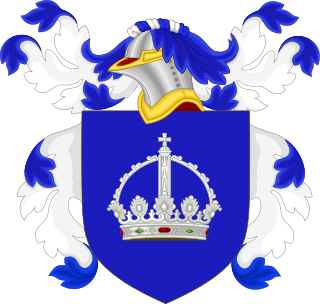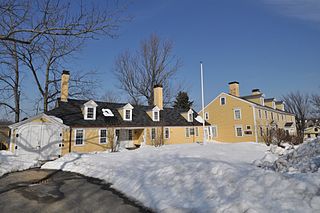
Coventry is a town in Tolland County, Connecticut. The population was 12,235 at the 2020 census. The birthplace of Captain Nathan Hale, Coventry is home to the Nathan Hale Homestead, which is now a museum open to the public. Coventry was incorporated in May 1712.

Litchfield is a city in and the county seat of Meeker County, Minnesota, United States. The population was 6,726 at the 2010 census.

Orange is a town in New Haven County, Connecticut, United States. The population was 14,280 at the 2020 census. The town is governed by a Board of Selectmen.

Newburgh is a town in Orange County, New York, United States. It forms part of the Poughkeepsie—Newburgh—Middletown metropolitan area, which is a part of the New York megacity, and is a suburban satellite of the urbanized city of Newburgh. The city of Newburgh was a part of the town prior to 1865. New York Stewart International Airport is partially located within the township, and much of the land into which it could have been expanded has been turned into Stewart State Forest.

The town of Stonington is located in New London County, Connecticut in the state's southeastern corner. It includes the borough of Stonington, the villages of Pawcatuck, Lords Point, and Wequetequock, and the eastern halves of the villages of Mystic and Old Mystic. The population of the town was 18,335 at the 2020 census.

Monaghan is the county town of County Monaghan, Ireland. It also provides the name of its civil parish and barony.

The Crowninshield family is an American family that has been prominent in seafaring, political and military leadership, and the literary world. The founder of the American family emigrated from what is now Germany in the 17th century. The family is one of several known collectively as Boston Brahmins.

Nathaniel Peter Hill was a professor at Brown University, a mining executive and engineer, and a politician, including serving in the United States Senate. Originally from the state of New York, he came to Colorado following the Pike's Peak Gold Rush to try his hand at mining. He traveled to Europe to investigate ways to smelt ore and developed processes to make mining more profitable. He was the mayor of Denver before becoming a United States Senator.

The Ladd-Gilman House, also known as Cincinnati Memorial Hall, is a historic house at 1 Governors Lane in Exeter, New Hampshire, United States. The home was built about 1721 by Nathaniel Ladd as one of the state's first brick houses, and was subsequently clapboarded three decades later. The home was purchased in 1747 by Daniel Gilman, a prominent Exeter merchant. It served as the state treasury during the American Revolutionary War when two members of the Gilman family, Col. Nicholas Gilman and his son John Taylor Gilman, later the state's governor, served as treasurers of the state. Also born in the house was Nicholas Gilman, Jr., a signer of the United States Constitution and U.S. senator from New Hampshire.

The Phillips Mansion is a Second Empire style historic house in Pomona, Los Angeles County, California. It was built in 1875 by Louis Phillips, who by the 1890s had become the wealthiest man in Los Angeles County. Situated along the Butterfield Stage route, the Phillips Mansion became a center of community activity in the Pomona and Spadra area. It was added to the National Register of Historic Places in 1974, making it among the first 25 sites in Los Angeles County to be so designated.
The Montclair History Center, located in Montclair, New Jersey consists of a campus at 108–110 Orange Road, Montclair, New Jersey 07042 with three historic buildings. The first building is the Crane House and Historic YWCA, a Federal Revival style home dating from 1796. The Montclair Historical Society (MHS) was founded in 1965 to save the Israel Crane House, which was moved from its original location near Lackawanna Plaza in downtown Montclair. The Crane House and Historic YWCA was used as a Y for African American ladies from the 1920s to 1965. This location also includes the Nathaniel Crane build by a relative of Israel Crane in 1818 and the Clark House, a Queen Anne style home built in 1894, which contains the administrative offices of the Montclair History Center.

Long Branch is a historic family seat in Millwood, Virginia built in the early 19th century; named after the creek that runs through the property. Built on approximately 1000 acres by Robert Carter Burwell in 1811 and owned by the Burwell-Nelson family until 1957. The property was placed on the National Register on October 1, 1969.

The Newlin Mill Complex, also referred to as The Newlin Grist Mill, is a water-powered gristmill on the west branch of Chester Creek near Concordville, Pennsylvania was built in 1704 by Nathaniel and Mary Newlin and operated commercially until 1941. During its three centuries of operation, the mill has been known as the Lower Mill, the Markham Mill, the Seventeen-O-Four Mill and the Concord Flour Mill. In 1958 the mill property was bought by E. Mortimer Newlin, restored and given to the Nicholas Newlin Foundation to use as a historical park. Water power is still used to grind corn meal which is sold on site. The park includes five historical buildings, which were added to the National Register of Historic Places in 1983, and 150 acres (61 ha) of natural woodland.

Stone House by the Stone House Brook, also known as Old Stone House, is located at 219 South Orange Avenue in South Orange, Essex County, New Jersey, United States. It is one of the oldest extant structures in New Jersey, the original portion house built prior to 1680. The building was added to the National Register of Historic Places on November 22, 1991, for its significance in historic archaeology, education, community planning and development, and politics/government.

Sutton-Ditz House is a historic home and museum located in Clarion, Clarion County, Pennsylvania. It was built in 1847, and remodeled in 1909-1910.

Stephen W Williams or Stephen Williams (1837–1899) was a civil engineer and architect who worked mainly in Radnorshire and Breconshire, Wales. He was county surveyor of Radnorshire from 1864–1899. He had offices at Rhayader and lived at Penralley House, Rhayader, He became a noted authority on the archaeology of the Cistercian Monasteries in Wales and undertook excavations at Strata Florida Abbey in Ceredigion, Abbey Cwm Hir in Radnorshire and Strata Marcella near Welshpool in Montgomeryshire. He was appointed High Sheriff of Radnorshire in 1899.
Benjamin Deyerle (1806–1883) was an architect, artist and brickmaker in Roanoke County, Virginia. Many of the historic homes, churches and public buildings in Roanoke were designed and built under his and his family's direction. He is credited with building 23 of them, and perhaps more. Some of these homes and buildings are currently listed on both the National Register of Historic Places and the Virginia Landmarks Register.

Jarvisfield is a heritage-listed former pastoral property and now golf course at Old Hume Highway, Picton, Wollondilly Shire, New South Wales, Australia. It was designed by William Weaver, architect-engineer, and built from 1815 to 1864. It is also known as Wilton. The property is owned by the Wollondilly Shire Council. It was added to the New South Wales State Heritage Register on 2 April 1999.


















